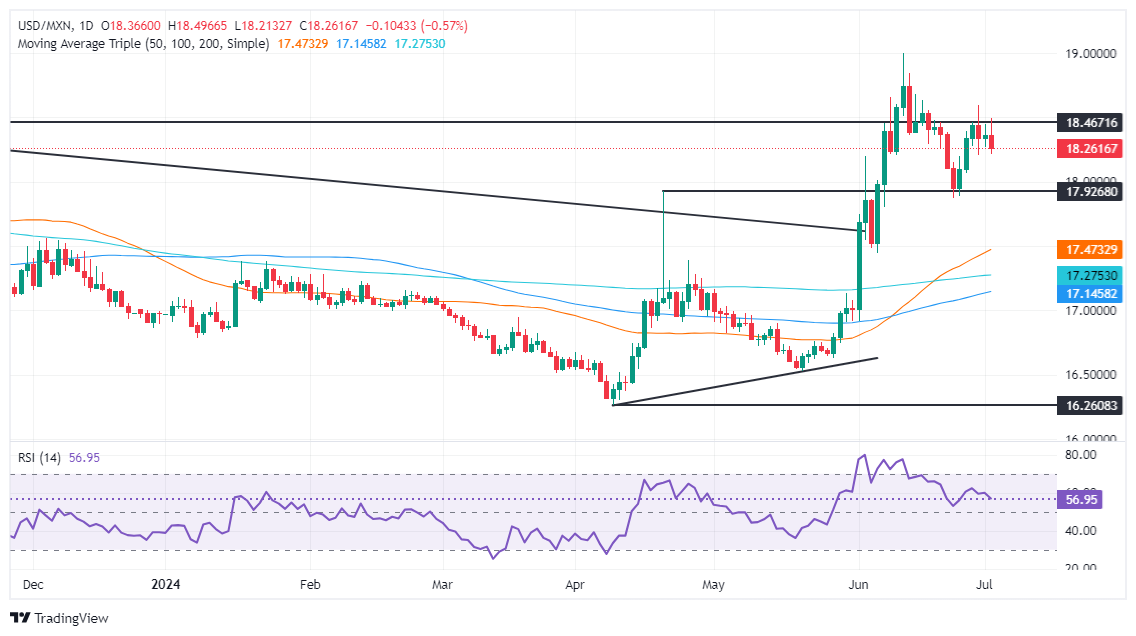Mexican Peso surges as Powell’s remarks weaken US Dollar

- Mexican Peso rallies after dovish remarks from Fed Chair Powell.
- Powell highlights progress on US inflation, hints at balanced risks.
- Banxico Governor Rodriguez Ceja suggests possible future rate cuts as disinflation persists.
- Banxico survey adjusts GDP, policy outlook down, forecasts 2024 USD/MXN rate at 18.73 from 17.80.
The Mexican Peso advanced against most currencies on Tuesday, particularly the US Dollar, after Federal Reserve (Fed) Chairman Jerome Powell delivered remarks perceived as dovish by market participants. This punished the Greenback, which lost some 0.55% as the USD/MXN traded at 18.25 below its opening price.
Powell commented that the US economy made significant progress on inflation while adding that the risks of the Fed’s dual mandate are more balanced. His remarks came before the release of May’s JOLTs report, which came in hotter than expected.
Aside from this, the Mexican currency gained some traction even though Bank of Mexico Governor Victoria Rodriguez Ceja was dovish, adding that the progress of disinflation can “allow us to continue discussing downward adjustments in our rate, and I consider that this is what we will be doing in our next monetary policy meetings.”
Mexico’s economic docket featured Gross Fixed Investment in April, which showed mixed readings between monthly and annual figures.
Meanwhile, Banxico’s latest survey of economic expectations showed that most private analysts have revised the Gross Domestic Product (GDP) and their monetary policy expectations downward. Regarding the USD/MXN exchange rate for 2024, economists lifted their forecasts from 17.80 to 18.73.
Daily digest market movers: Mexican Peso climbs despite expected economic deceleration
- Banxico’s survey showed that economists estimate the Gross Domestic Product (GDP) to end at 2%, down from 2.1%. They expect Banxico to cut rates from 11.00% to 10.25%, up from 10.00% projected in May.
- Mexico’s Gross Fixed Investment increased in April from 0.8% to 0.9% MoM but missed estimates of 1.2%. On an annual basis, investment grew 18.1%, crushed March’s 3%, and exceeded forecasts for a 17.1% increase.
- US job openings rose in May from 7.919 million to 8.14 million, exceeding the 7.91 million projected by the consensus, revealed the US Bureau of Labor Statistics (BLS).
- US business activity in the manufacturing sector was mixed, according to S&P Global Manufacturing and the Institute for Supply Management (ISM). Traders are eyeing the release of the services sector on Wednesday.
- CME FedWatch Tool shows odds for a 25-basis-point Fed rate cut in September at 63%, up from 58% on Monday.
Technical analysis: Mexican Peso gains traction as USD/MXN slumps below 18.30
The USD/MXN failed to decisively crack the June 28 high of 18.59, which prompted market participants to sell the pair, which dropped below 18.30. Momentum is still in favor of buyers but aims lower, suggesting that in the near term sellers are in control.
If USD/MXN tumbles further, the next stop would be the psychological 18.00 figure. Once cleared, the next support level would be the December 5 high turned support at 17.56 before sliding toward the 50-day Simple Moving Average (SMA) at 17.37.
On the flip side, if buyers lift the spot price above 18.50, that will exacerbate a rally toward the June 28 high of 18.59 if they would like to extend their gains and challenge the year-to-date high of 18.99.
Mexican Peso FAQs
The Mexican Peso (MXN) is the most traded currency among its Latin American peers. Its value is broadly determined by the performance of the Mexican economy, the country’s central bank’s policy, the amount of foreign investment in the country and even the levels of remittances sent by Mexicans who live abroad, particularly in the United States. Geopolitical trends can also move MXN: for example, the process of nearshoring – or the decision by some firms to relocate manufacturing capacity and supply chains closer to their home countries – is also seen as a catalyst for the Mexican currency as the country is considered a key manufacturing hub in the American continent. Another catalyst for MXN is Oil prices as Mexico is a key exporter of the commodity.
The main objective of Mexico’s central bank, also known as Banxico, is to maintain inflation at low and stable levels (at or close to its target of 3%, the midpoint in a tolerance band of between 2% and 4%). To this end, the bank sets an appropriate level of interest rates. When inflation is too high, Banxico will attempt to tame it by raising interest rates, making it more expensive for households and businesses to borrow money, thus cooling demand and the overall economy. Higher interest rates are generally positive for the Mexican Peso (MXN) as they lead to higher yields, making the country a more attractive place for investors. On the contrary, lower interest rates tend to weaken MXN.
Macroeconomic data releases are key to assess the state of the economy and can have an impact on the Mexican Peso (MXN) valuation. A strong Mexican economy, based on high economic growth, low unemployment and high confidence is good for MXN. Not only does it attract more foreign investment but it may encourage the Bank of Mexico (Banxico) to increase interest rates, particularly if this strength comes together with elevated inflation. However, if economic data is weak, MXN is likely to depreciate.
As an emerging-market currency, the Mexican Peso (MXN) tends to strive during risk-on periods, or when investors perceive that broader market risks are low and thus are eager to engage with investments that carry a higher risk. Conversely, MXN tends to weaken at times of market turbulence or economic uncertainty as investors tend to sell higher-risk assets and flee to the more-stable safe havens.
